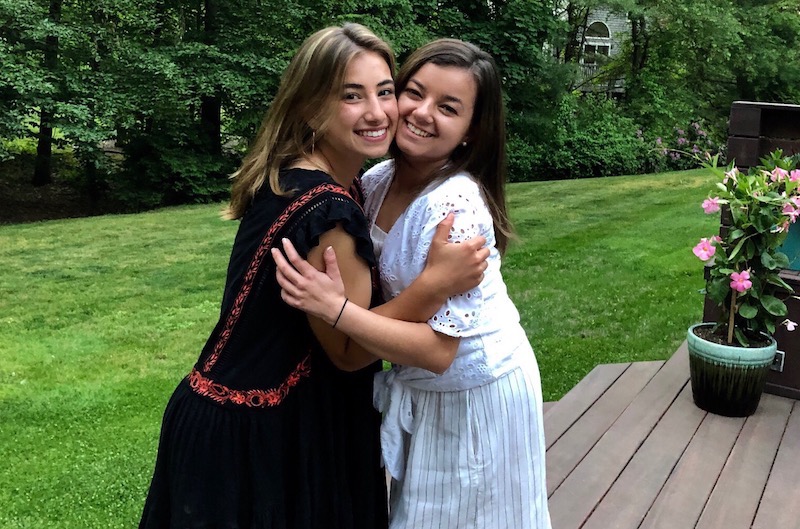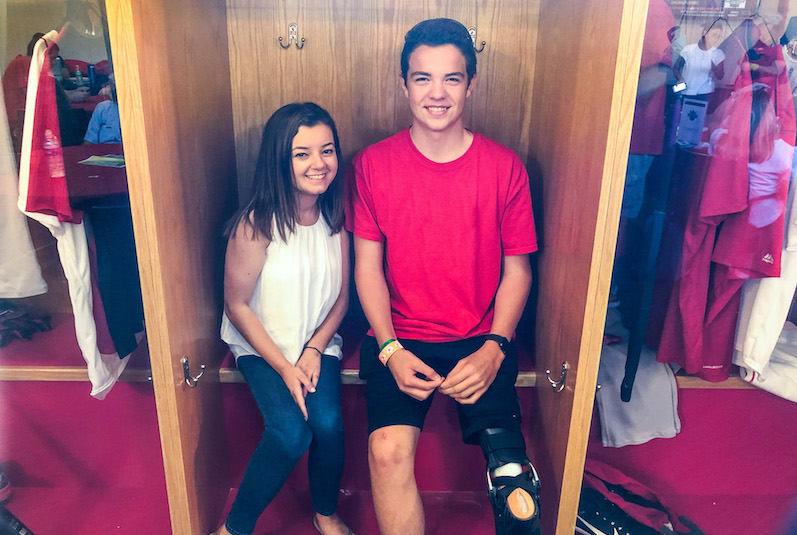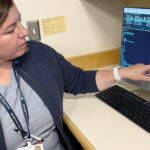Teen cancer survivor rediscovers her confidence with prosthesis

At just 18 years old, Gabbi Stewart is a two-time survivor of two very different types of cancer. While her care team acted quickly to aggressively treat her most recent cancer, Stewart was faced with what she says was her greatest challenge: building back the self-confidence that the disease had eroded.
A rare diagnosis
In 2003, a 2-year-old Gabbi was diagnosed with leukemia, a type of blood cancer. After two years of treatment, she underwent a successful bone marrow transplant at Dana-Farber/Boston Children’s Cancer and Blood Disorders Center. Gabbi remained in remission until last year, when she learned her experience with cancer wasn’t over just yet.
In 2018, she suddenly started experiencing a sharp, shooting pain in her right foot. It took doctors weeks to figure out what was causing the pain, but a biopsy ultimately revealed she had a peripheral nerve sheath tumor.
“I had already survived cancer once before, so the diagnosis didn’t worry me. I was ready to beat this disease again,” says Gabbi.
A peripheral nerve sheath tumor is one that develops in the soft tissues surrounding the peripheral nerves, which are responsible for movement. Peripheral nerves branch out from the central nervous system (consisting of the brain and spinal cord) and relay movement back to them. According to the Genetic and Rare Diseases Information Center, these tumors affect just 0.001 percent of the population. While it remains unclear what exactly caused Gabbi’s tumor, it is unlikely her previous leukemia diagnosis, which is the most common childhood cancer, played a role.
Surgery and a difficult transition
Gabbi was placed under the care of Dr. Natalie Collins in the pediatric Solid Tumor Center at Dana-Farber/Boston Children’s. Shortly after meeting Dr. Collins, she was introduced to an orthopedic tumor surgeon, Dr. Megan Anderson, as it was clear her tumor would require surgical removal. Together, the team would guide Gabbi through her treatment.
Due to the size and location of her tumor, chemotherapy and radiation weren’t needed for treatment, but Dr. Anderson would have to amputate Gabbi’s foot. Dr. Anderson notes this important conversation spanned over several meetings, so Gabbi had the opportunity to meet with a physical therapist, a prosthetist (someone who creates and fits patients for prosthetic limbs), and another patient who had a similar procedure.
“It is a delicate and difficult conversation,” adds Dr. Anderson. “With Gabbi, I focused on the benefits of the surgery, and making sure she felt comfortable, because it was her best chance for cure.”
“I knew my life was going to be very different after the surgery,” recalls Gabbi. “But I also knew this was something I had to do.”
Gabbi had the surgery in May 2018 and has been in remission since. While the surgery itself was straightforward, she says coming to grips with the physical effects of the procedure wasn’t as easy.
One way Gabbi’s care team worked to address her concerns was by constructing a prosthetic that looked as natural as possible. Through multiple meetings with the prosthetist, she was able to match her new prosthetic foot very closely to her other foot.
A growing confidence
Even with such a realistic prosthetic, Stewart says she wasn’t ready to utilize her whole wardrobe at first. It wasn’t until she received an email from Lisa Scherber, director of Patient and Family Programs at the Jimmy Fund Clinic, that she felt ready to embark on her journey to personal healing.
Scherber invited her to join the clinic’s annual trip to the Red Sox spring training camp in Fort Myers, Florida. Each year, a large group of teenage patients and clinician-chaperones fly to Florida for a trip that allows them to connect with one another, enjoy the sun, meet players from the Boston Red Sox, and of course, catch a game. Excited for the chance to escape the cold New England weather and watch the Red Sox play, Gabbi jumped at the opportunity.

“The main goal of our adolescent events is to create friendships between these courageous teens. These friendships help get them through this journey that changed their lives forever,” says Scherber. “Meeting the Red Sox players is phenomenal, but connecting with another teen that allows you to feel accepted, and make you laugh again, is why we do it!”
While at the hotel pool on the first day, Gabbi struck up a conversation with a few other teen patients who also made the trip. Between laughs and jokes, they took turns sharing their stories. Gabbi felt an instant connection among the group, and says it was the first time since her surgery she felt comfortable being herself.
“Everyone is very open about what they’ve been through, because we’ve all experienced some really tough stuff,” she says. “Knowing that, it was really easy to talk to them and I felt I could connect with them.”
Celebrating each victory
Since the trip, Gabbi’s confidence has only grown. She’s back to choosing clothes from her entire closet, and has no problem wearing leggings, shorts, or even sandals, with her prosthesis. With each personal victory, her friends, family, and care team at Dana-Farber/Boston Children’s are all able to witness the positive changes.
“She has really blossomed and adapted to her prosthetic limb,” says Dr. Anderson. “Watching her find her own path in adaptation has been remarkable.”
In September, Gabbi began her freshman year at Lasell University, where she is studying health sciences. She hopes to become a doctor, specifically working with patients at the Jimmy Fund Clinic.
“I’d like to go full circle and help patients go through what I’ve been through,” Gabbi explains. “I want to help them because I am proof you can get through it.”
Learn more about the Dana-Farber/Boston Children’s Cancer and Blood Disorders Center.
Related Posts :
-

Ask a sports medicine specialist: Why are ACL tears so common among female athletes?
When an athlete is sprinting after an opponent who suddenly stops or changes direction, their anterior cruciate ligaments (ACLs) make ...
-

Forging a path back to school after orthopedic trauma
Orthopedic trauma can force children to miss school, sometimes for an extended period. But even when patients have regained enough ...
-

A new druggable cancer target: RNA-binding proteins on the cell surface
In 2021, research led by Ryan Flynn, MD, PhD, and his mentor, Nobel laureate Carolyn Bertozzi, PhD, opened a new chapter ...
-

Jackie’s dreams of playing professional soccer back on track after ACL surgery
From her dorm in Newcastle, England, Jackie Zapata can hear fans roaring in the soccer stadium a few blocks away. ...





